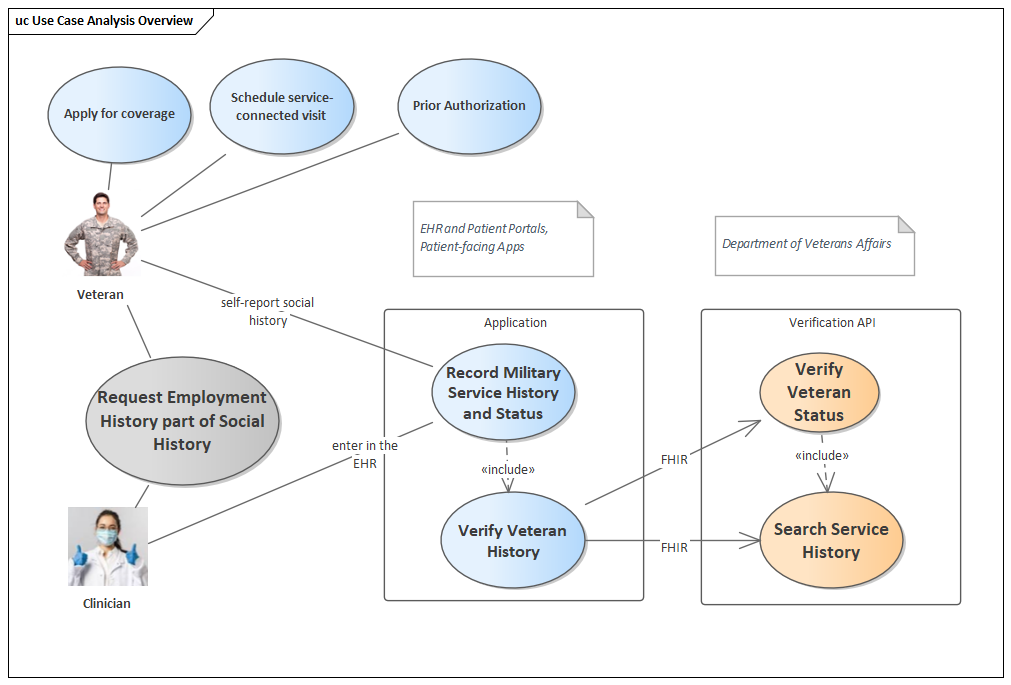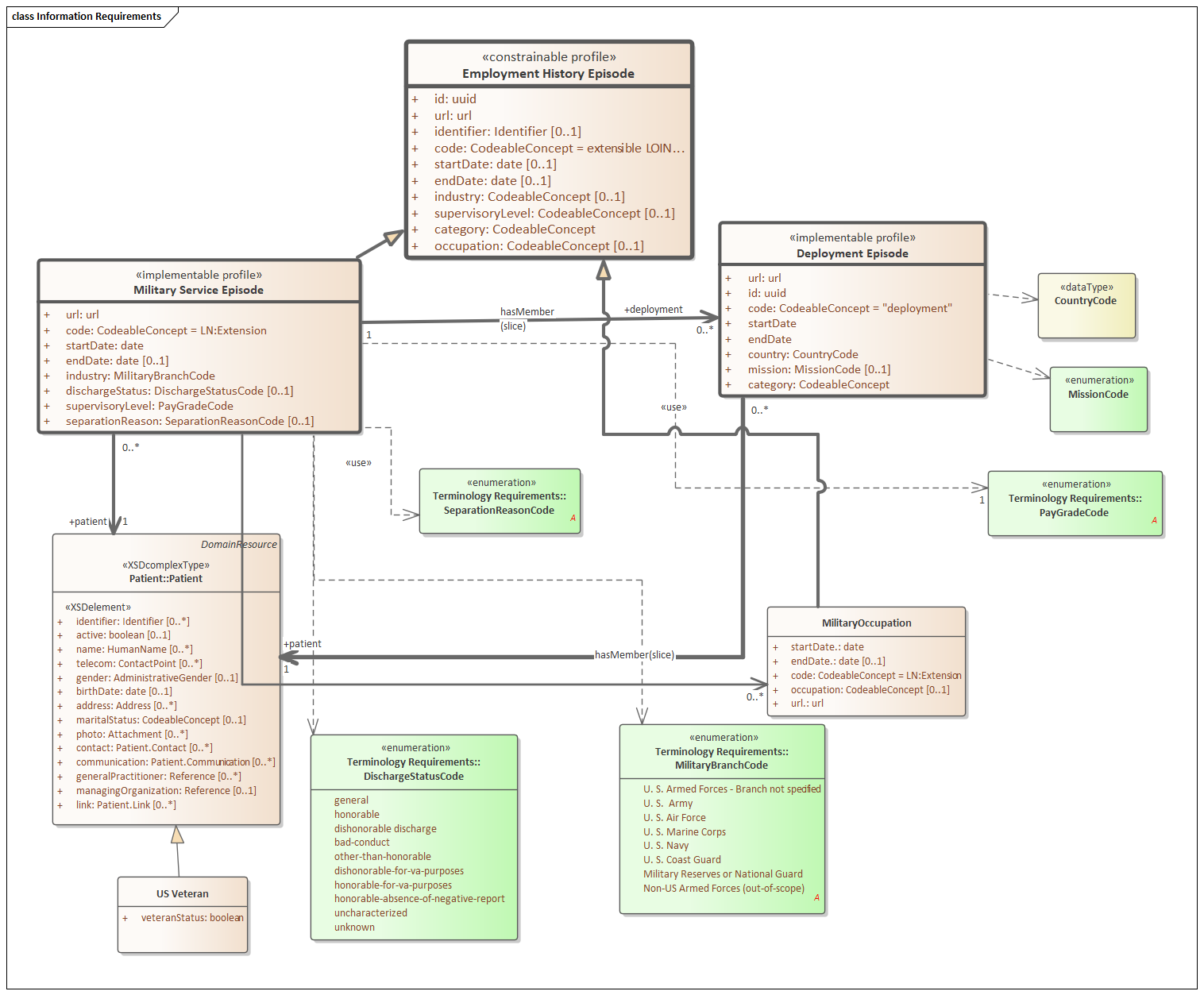HL7 FHIR Implementation Guide: Military Service History and Status Release 1 - US Realm | STU1, published by Cross Group Projects WG. This is not an authorized publication; it is the continuous build for version 1.0.0). This version is based on the current content of https://github.com/HL7/fhir-military-service/ and changes regularly. See the Directory of published versions
| Official URL: http://hl7.org/fhir/us/military-service/ImplementationGuide/hl7.fhir.us.military-service | Version: 1.0.0 | |||
| Active as of 2023-05-30 | Computable Name: MilitaryService | |||
This implementation guide contains profiles and extensions to share Military Service History and Status using FHIR-based application programming interfaces (APIs) consistent with US regulatory requirements (i.e. Title 38 Veteran Benefits). This is a US-realm specificatoin but it is extensible to other realms/jurisdictions (e.g. Canadian Forces). It harmonizes the requirements of the U.S. Department of Veterans Affairs (VA) and the Centers for Disease Control and Prevention (CDC) to record this information support of administrative and clinical workflows (e.g. exchange with community providers) and the work and social history of patients who are also Veterans.
The use case anlaysis describes requirements and associated capabilities to manage and exchange information about Military Service History and Status. All requirements are analyzed as use cases involving actors/participants and system interactions.
Note: Certain requirements were discussed, deemed to be out-of-scope, and deferred (see Deferred Requirements).
Figure 1 is a summary of scenarios (use cases) representing the requirements for recording self-reported military and combat history. It also illustrates how FHIR-based APIs can be used to validate employment history information reported by Veterans.
 Figure 1: Use Case Analysis Overview
Figure 1: Use Case Analysis Overview
The clinician may be working with Veteran in the community and must assess the health risks associated with military service.
The Veteran is the focus of this specification. The API described here allows Veterans to access and share their military service history and status information with community and hospital-based clinicians, community service agencies, vendors, and employers, etc. The Veteran can access their information or make it available to entities that assist Veterans. Military Service History may be combined with other employment history information.
The clinician is requesting employment information in conjunction with their social history. If the patient is a Veteran, their employment history will include military service information. This was a core requirement of the Occupational Data for Heath (ODH) Implementation Guide we analyzed and reused. The current specification expands this use case to specify application (i.e. EHR) capabilities as well as reusable FHIR-based APIs that may be provided by an authoritative organization (e.g. US Department of Veterans Affairs).
The social history information reported by the patient - including employment and military service history - is entered into a system of record used to capture such information and not explicitly EHR.
The EHR system, acting as a FHIR client, uses a standards-based VA RESTful API (FHIR Observation with profiles and extensions) to verify that the patient is a Veteran and served in the military.
The query is triggered by an EHR. Based on the verification result,the EHR may validate the Veteran status and fill in the combat episodes as needed to determine social history risks.
Official records and documentation from the military service record, DD214, and other pre–existing documentation can be referenced in the verification process.
The Verification API proposed in this document determines the Veteran’s status by using demographic information submitted as a query (search operation) to a FHIR server that supports Observation resource - - using the Patient endpoint to determine whether a person is a verified veteran. Additional information is provided using the Search Service History criteria using the profiles described in the Information Requirements section (see Military Service Episode).
This use case is part of the proposed verification API based on FHIR. If this search operation returns one or more Observation resources that conform [Military Service Episode]((StructureDefinition-military-service-episode.html) to the proposed profile, the Veteran’s status confirmed. If the search operation does not find any matching Observation resources, the Veteran’s service history could not be confirmed.
The presence of one or more Observations that conform to the Deployment Episode profile proposed here indicates that Veteran was deployed.
The following use cases were discussed and deferred because they are out-of-scope for the profiles and extensions described in this implementation guide design document:
This section describes the result harmonizing requirements to convey military service history and status at this time. It also harmonizes the content of the Occupational Data for Health Implementation Guide developed by CDC to enhance social history and employment history reporting from EHR systems.
Figure 2 summarizes the proposed profiles and extensions needed to document military service history. The profiles described here constrain and extend the normative Observation resources profile (Release 4 and later) to ensure stability and reusability. FHIR Release 4 marked the first time some FHIR resources have attained normative status and will be maintained in a manner that ensure backwards-compatibility. Furthermore, using Observation R4 and later - rather than Basic resource - is the recommended approach to creating extensible APIs based on FHIR.
 Figure 2: Information Requirements
Figure 2: Information Requirements
Note: FHIR implementation, localization, and profiling best-practices are under development and evolving. This design document is intended to provide reasoning and context for future projects.
This implementation guide builds upon existing FHIR implementation guidance and best practices:
The project team would like to thank our leadership and colleagues for their support in the development of Application Programming Interface (API) implementation guide:
Department of Veterans Affairs:
Cross-Group Project (CGP) Work Group Co-chairs:
Project team:
ALTARUM
VA Developer API (Lighthouse Project):
Defense Health Agency:
CDC NIOSH:
MITRE: